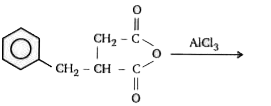Which of the following would not given 2 - phenylbutane as the major product in a Friedel - Crafts reaction with benzene?
1 - butene + HF
2 - butanol +H2SO4
Butanoylchloride +AlCl3 then Zn−Hg/HCl
Butyl chloride +AlCl3
The correct Answer is:C
To solve the question of which of the following reagents would not give 2-phenylbutane as the major product in a Friedel-Crafts reaction with benzene, we will analyze each of the given reagents step-by-step.
Step 1: Understand the structure of 2-phenylbutane
2-phenylbutane has the following structure:
- It consists of a butane chain (four carbon atoms) with a phenyl group (C6H5) attached to the second carbon.
- The molecular formula is C10H14.
Step 2: Analyze the reagents one by one
1. Reagent 1: 1-Butane + HF
- 1-butane can undergo protonation in the presence of HF, leading to the formation of a carbocation.
- This carbocation can then react with benzene to form 2-phenylbutane.
- Conclusion: This reagent will give 2-phenylbutane.
2. Reagent 2: 2-Butanol + H2SO4
- 2-butanol can be protonated by sulfuric acid, leading to the formation of a stable carbocation.
- This carbocation can then react with benzene to yield 2-phenylbutane.
- Conclusion: This reagent will also give 2-phenylbutane.
3. Reagent 3: Butanoyl chloride + AlCl3
- Butanoyl chloride (an acyl chloride) undergoes Friedel-Crafts acylation in the presence of AlCl3.
- The acyl group (C=O) will attach to the benzene ring, forming an acylated product.
- Upon reduction (Clemensen reduction) with zinc amalgam and HCl, the carbonyl group will be converted to a methylene group (–CH2–).
- The product formed will be 1-phenylbutane, not 2-phenylbutane.
- Conclusion: This reagent will NOT give 2-phenylbutane.
4. Reagent 4: Butyl chloride + AlCl3
- Butyl chloride can form a carbocation in the presence of AlCl3.
- This carbocation can rearrange to a more stable secondary carbocation and react with benzene to form 2-phenylbutane.
- Conclusion: This reagent will give 2-phenylbutane.
Final Answer
The reagent that would NOT give 2-phenylbutane as the major product in a Friedel-Crafts reaction with benzene is Butanoyl chloride + AlCl3.
---
2-phenylbutane has the following structure:
- It consists of a butane chain (four carbon atoms) with a phenyl group (C6H5) attached to the second carbon.
- The molecular formula is C10H14.
- 1-butane can undergo protonation in the presence of HF, leading to the formation of a carbocation.
- This carbocation can then react with benzene to form 2-phenylbutane.
- Conclusion: This reagent will give 2-phenylbutane.
- 2-butanol can be protonated by sulfuric acid, leading to the formation of a stable carbocation.
- This carbocation can then react with benzene to yield 2-phenylbutane.
- Conclusion: This reagent will also give 2-phenylbutane.
- Butanoyl chloride (an acyl chloride) undergoes Friedel-Crafts acylation in the presence of AlCl3.
- The acyl group (C=O) will attach to the benzene ring, forming an acylated product.
- Upon reduction (Clemensen reduction) with zinc amalgam and HCl, the carbonyl group will be converted to a methylene group (–CH2–).
- The product formed will be 1-phenylbutane, not 2-phenylbutane.
- Conclusion: This reagent will NOT give 2-phenylbutane.
- Butyl chloride can form a carbocation in the presence of AlCl3.
- This carbocation can rearrange to a more stable secondary carbocation and react with benzene to form 2-phenylbutane.
- Conclusion: This reagent will give 2-phenylbutane.
The reagent that would NOT give 2-phenylbutane as the major product in a Friedel-Crafts reaction with benzene is Butanoyl chloride + AlCl3.
Similar Questions
Knowledge Check

What is the major product of above Friedel-Craft reaction ?A B
B C
C D
D

Product of the above Friedel-Craft reaction is :A B
B C
C D
D
The action of AlCl3 in Friedel Craft's reaction is:
Ato absorb HClBto release HClCto produce electrophileDto produce nucleophile
Explain the following reactions:
Friedel-Craft's reaction
View SolutionThe reagent used for Friedel-Craft's reaction is :
View SolutionWhich of the following compounds do not give Friedel Crafts reaction?
View SolutionWhich is the major product of the following reaction ?

View SolutionWhich of the following reactions do not represent the major product of given Birch reductions ?

View Solution
